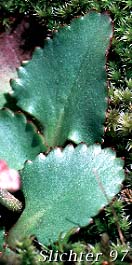 Leaves of the western saxifrage at right.
Leaves of the western saxifrage at right.
Western saxifrage is a perennial with single, simple stems arising from 5-20 cm high from a cluster of several basal leaves. The stems arise from a short rhizome, are short-hairy, and are often reddish-glandular. The thick leaf blades are elliptical or egg-shaped, or occasionally roughly triangular in outline with coarsely toothed margins (15-30 teeth). The blade tapers gradually to a broad petiole, or occasionally rather abruptly to the petiole, giving the leaf in that case a triangular outline. The blades are up to 6 cm long and to 3 cm wide and may be rusty-hairy beneath.
The inflorescence is a narrow to widely branched cyme. The result may be tightly clustered to widely spaced flowers. The flowers are about 5-6 mm wide, usually white with 10 yellow spots near the center. There are 5 petals, and each is egg-shaped. The sepals are blunt-tipped and reflexed out from the petals.
Western saxifrage may be found on seasonally moist (spring) slopes, cliffs, and banks from sea level to alpine habitats.
Western saxifrage may be found from British Columbia south on both sides of the Cascades to northwest Oregon, and east across Oregon and Washington to Idaho, Montana, northwestern Wyoming, and as far south as Elko County, Nevada. In Canada, it may be found as far east as Alberta.